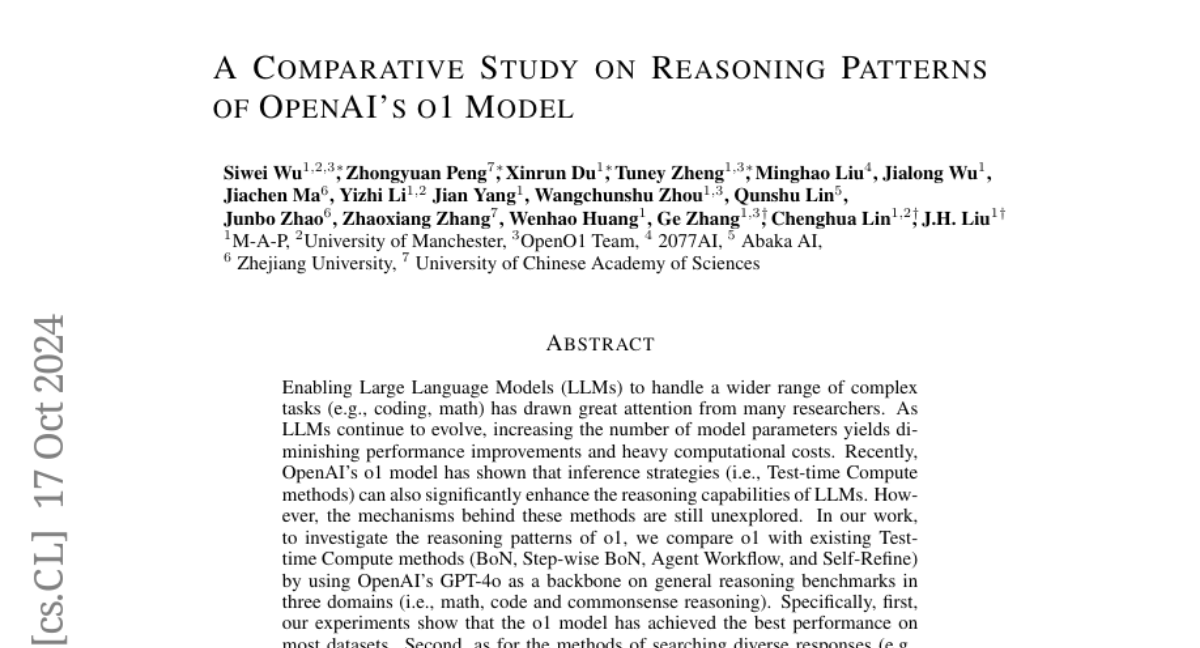A Comparative Study on Reasoning Patterns of OpenAI's o1 Model
Siwei Wu, Zhongyuan Peng, Xinrun Du, Tuney Zheng, Minghao Liu, Jialong Wu, Jiachen Ma, Yizhi Li, Jian Yang, Wangchunshu Zhou, Qunshu Lin, Junbo Zhao, Zhaoxiang Zhang, Wenhao Huang, Ge Zhang, Chenghua Lin, J. H. Liu
2024-10-18

Summary
This paper explores the reasoning patterns of OpenAI's o1 model, comparing it with other methods to see how well it handles complex tasks like math, coding, and commonsense reasoning.
What's the problem?
As large language models (LLMs) become more advanced, simply making them bigger isn't enough to improve their performance on complex tasks. Traditional methods for enhancing these models often lead to diminishing returns and high costs. Additionally, the specific strategies used to improve reasoning capabilities in models like OpenAI's o1 are not well understood.
What's the solution?
To investigate these issues, the authors conducted experiments comparing the o1 model with several existing methods, including Best-of-N (BoN), Step-wise BoN, Agent Workflow, and Self-Refine. They focused on how well each method performed across different reasoning tasks. The study identified six distinct reasoning patterns used by the o1 model, which helped clarify how it achieves better results compared to other methods. The findings showed that the o1 model generally outperformed others in most datasets and that certain methods were more effective at breaking down complex problems into manageable parts.
Why it matters?
This research is important because it provides insights into how AI models can be improved for complex reasoning tasks. By understanding the reasoning patterns of the o1 model and how it compares to other methods, developers can create more effective AI systems that excel in areas like coding and math. This could lead to advancements in AI applications that require deep understanding and problem-solving abilities.
Abstract
Enabling Large Language Models (LLMs) to handle a wider range of complex tasks (e.g., coding, math) has drawn great attention from many researchers. As LLMs continue to evolve, merely increasing the number of model parameters yields diminishing performance improvements and heavy computational costs. Recently, OpenAI's o1 model has shown that inference strategies (i.e., Test-time Compute methods) can also significantly enhance the reasoning capabilities of LLMs. However, the mechanisms behind these methods are still unexplored. In our work, to investigate the reasoning patterns of o1, we compare o1 with existing Test-time Compute methods (BoN, Step-wise BoN, Agent Workflow, and Self-Refine) by using OpenAI's GPT-4o as a backbone on general reasoning benchmarks in three domains (i.e., math, coding, commonsense reasoning). Specifically, first, our experiments show that the o1 model has achieved the best performance on most datasets. Second, as for the methods of searching diverse responses (e.g., BoN), we find the reward models' capability and the search space both limit the upper boundary of these methods. Third, as for the methods that break the problem into many sub-problems, the Agent Workflow has achieved better performance than Step-wise BoN due to the domain-specific system prompt for planning better reasoning processes. Fourth, it is worth mentioning that we have summarized six reasoning patterns of o1, and provided a detailed analysis on several reasoning benchmarks.